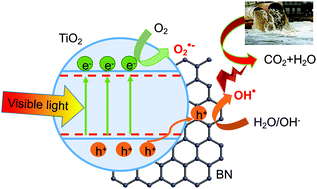Enhanced visible light photocatalysis by TiO2–BN enabled electrospinning of nanofibers for pharmaceutical degradation and wastewater treatment
Abstract
Boron nitride (BN) nanosheets are promising support materials for catalysts. A series of TiO2–BN enabled electrospun nanofibers were synthesized for the photocatalytic treatment of ibuprofen and secondary wastewater effluent under visible light. X-ray photoelectron spectroscopy confirmed the existence of B–O–Ti bonds between the BN nanosheets and TiO2 nanofibers, resulting in energy rearrangement, narrowed band gaps, and enhanced light utilization efficiency of the TiO2–BN nanocomposites in the visible light spectrum. Transient photocurrent measurements revealed that the BN enhanced the transport of photogenerated holes from the bulk TiO2 nanofibers to its surface, resulting in more efficient separation and less recombination of the charge carriers. A kinetic study of ibuprofen degradation indicated the enhanced photocatalytic performance of TiO2–BN catalysts with a higher BN content in the nanocomposites. The kinetic rate constant of the TiO2–10% BN catalysts was 10 times higher than that of the pure TiO2 nanofibers. The degradation of organic contaminants in wastewater followed the same trend as ibuprofen and improved with increasing BN content. The stability of the TiO2–BN nanocomposites as an effective solar photocatalyst was demonstrated by multiple cycles of wastewater treatment. The results proved that TiO2–BN is an appealing photocatalyst under visible light.



 Please wait while we load your content...
Please wait while we load your content...